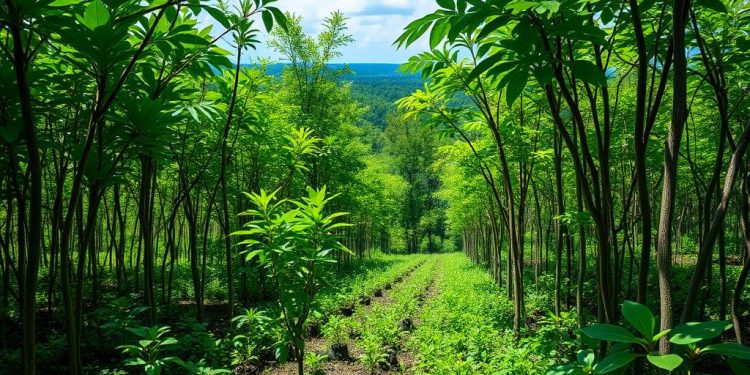In today’s world, Community-Led Conservation Projects are emerging as vital solutions to combat the alarming decline in biodiversity and habitat degradation. These initiatives empower local communities by allowing them to take charge of their natural resources while committing to local wildlife protection. By actively involving individuals in sustainability efforts, these grassroots initiatives resonate with the unique needs and priorities of their areas, resulting in innovative and effective conservation strategies.
For instance, the Community Baboon Sanctuary in Belize showcases how collaborative management can lead to remarkable outcomes. Over 120 landowners have committed to altering their land management practices to benefit biodiversity, which is evident as the black howler monkey population flourishes. This project not only enhances local ecosystems but also boosts the economy through sustainable practices like ecotourism, which includes guided nature hikes and local businesses.
Ultimately, by leveraging the strengths of local communities, community-led conservation projects contribute to long-lasting benefits for both ecosystems and the people that depend on them, highlighting the significance of environmental stewardship.
The Urgent Need for Community-Led Conservation
The world faces a significant biodiversity crisis characterized by severe species loss due to human activities. Understanding this crisis is essential for prioritizing community-led conservation efforts to enhance environmental stewardship. The interplay between biodiversity loss and habitat degradation necessitates immediate action at the local level.
Understanding the Biodiversity Crisis
According to the UN Convention on Biodiversity, none of the 20 Aichi biodiversity targets established in 2010 have been met. Alarmingly, up to one million species are at risk of extinction. Human activities, particularly land-use changes, significantly contribute to this dire situation. Research from the World Wildlife Fund highlights a staggering decline in wildlife populations, dropping by two-thirds over the past 50 years. These statistics underscore the urgency for proactive measures in community conservation to protect remaining biodiversity.
Impacts of Habitat Degradation
Habitat degradation caused by human actions poses formidable challenges for ecosystems. Approximately 75% of terrestrial ecosystems and 66% of marine environments have been altered, disrupting species migration and survival. This ecological crisis leads to economic repercussions, such as reduced agricultural productivity and increased susceptibility to natural disasters. Addressing habitat degradation through innovative community conservation strategies is vital for restoring ecological balance and promoting sustainability.
| Impact Area | Statistics | Community Action |
|---|---|---|
| Biodiversity Loss | 1 million species at risk of extinction | Community-led programs focusing on wildlife protection |
| Wildlife Population Decline | 63% decrease in populations over 50 years | Increased local conservation initiatives |
| Habitat Alteration | 75% of terrestrial ecosystems impacted | Restoration projects led by local communities |
| Sustainable Practices | 30% of land and marine areas to be conserved by 2030 | Empowering community stewardship efforts |
Challenges of Traditional Conservation Methods
Traditional conservation methods often encounter serious hurdles that undermine their effectiveness. These challenges primarily stem from a lack of integration with local communities and the financial burdens associated with conservation enforcement. Addressing these issues is essential for fostering sustainable solutions in the realm of community conservation.
Conflict with Local Communities
Many traditional conservation initiatives face significant conflict with local communities. For instance, data reveals that between 1999 and 2020, over 13,450 families in India were displaced due to wildlife conservation projects aimed at creating protected areas. The Democratic Republic of Congo has also witnessed tragic confrontations, with local inhabitants suffering violence related to conservation measures. Such instances starkly highlight the urgent need for community involvement in conservation strategies that respect local needs and livelihoods.
High Costs of Enforcement
Enforcement challenges further complicate the landscape of traditional conservation. Implementing protection measures incurs high costs that many projects struggle to cover. Continuous surveillance is necessary to prevent illegal activities, yet the financial resources required can be prohibitively expensive. Corruption and illegal resource extraction exacerbate these costs, contributing to significant forest loss. In contrast, community conservation initiatives that share management responsibilities often prove to offer more economically sustainable alternatives, demonstrating the potential benefits of involving local stakeholders in conservation efforts.
Defining Community-Led Conservation Projects
Community-led conservation projects focus on empowering local communities to take charge of managing natural resources. This approach contrasts sharply with traditional conservation models, which often impose strict regulations without involving local populations. By promoting sustainable practices, these projects foster a symbiotic relationship between the people and the environment, enabling communities to protect and restore biodiversity while also supporting their livelihoods.
Data shows that 56% of conservation projects controlled by local communities yielded positive impacts on human well-being, habitats, and species. In comparison, only 16% of projects managed by external agencies reported similar positive outcomes. Many external conservation efforts ironically resulted in negative social consequences, highlighting the necessity for local empowerment in conservation strategies.
You will find that the significance of local knowledge cannot be overstated. Understanding the cultural values, needs, and traditions of residents can lead to much more effective conservation outcomes. By incorporating such insights, conservation initiatives not only protect wildlife but also enhance the quality of life for these communities.
For a more impactful approach, integrating health initiatives can play a significant role. For instance, building fuel-efficient stoves reduces dependence on firewood, thereby protecting ecosystems in areas like the Monarch Butterfly Biosphere Reserve. This initiative is crucial as deforestation contributes to habitat loss and compromises the survival of vulnerable species.
Benefits of Community-Led Conservation
Community-led conservation projects present numerous advantages that significantly contribute to wildlife protection and sustainable practices. Engaging local communities in conservation not only fosters environmental stewardship but also enhances social and economic outcomes for those involved. By creating partnerships among diverse stakeholders, these grassroots initiatives pave the way for improved biodiversity and healthier ecosystems.
Promoting Local Wildlife Protection
Research highlights that community involvement in conservation enhances wildlife protection. Protected areas managed by local communities often face reduced rates of deforestation and habitat loss compared to traditional conservation methods. This ownership encourages a tailored approach to environmental preservation, which adapts to the specific needs of local species and habitats. Moreover, approximately 56% of conservation projects led by these communities reported positive impacts on local habitats and species. Such data reflects the tangible benefits of empowering local populations in the conservation process.
Encouraging Sustainable Practices
Community-led projects foster sustainable land management practices that take local conditions into account. Engaging residents in decision-making processes aligns these initiatives with their needs and priorities, promoting greater community investment in environmental outcomes. As a result, these participatory approaches not only foster resilience against climate change but also support efforts to restore biodiversity. Innovative projects, such as the Patsari Stove Project in Mexico, showcase how effective community engagement can lead to ecological advantages while simultaneously addressing community health needs.
Successful Examples of Community-Led Conservation Projects
Exploring successful community-led conservation projects reveals effective models that have made significant impacts on local ecosystems and economies. The integration of local knowledge and community engagement has proven vital in these initiatives.
The Community Baboon Sanctuary in Belize
The Community Baboon Sanctuary stands as a noteworthy example of successful community-led conservation. Established in the 1980s, local landowners united to protect their lands for the black howler monkeys, resulting in a remarkable recovery of monkey populations. This sanctuary not only supports wildlife but also nurtures economic opportunities for community members through ecotourism.
Community Empowerment Initiatives
Across the globe, empowerment initiatives demonstrate how local engagement fosters successful community conservation outcomes. Programs encouraging stakeholder involvement in resource management enhance biodiversity protection and stimulate local economies. For example, in the Sustainable Southeast Partnership, local leaders embraced economic solutions that empower Indigenous stewardship. Through initiatives that prioritize local values, communities become stewards of their natural resources.
| Project Name | Location | Focus Area | Results Achieved |
|---|---|---|---|
| Community Baboon Sanctuary | Belize | Wildlife Protection | Increased black howler monkey populations and ecotourism revenue |
| Sustainable Southeast Partnership | Southeast Alaska | Indigenous Stewardship | Empowered communities to manage resources sustainably |
| Coral Triangle Initiative | Various Southeast Asian countries | Fisheries Management | Enhanced fishing practices and resource sustainability |
| Chipko Movement | India | Forest Conservation | Stricter forest management regulations and community engagement |
Grassroots Initiatives Driving Change
Grassroots initiatives play a vital role in fostering community-led change and enhancing environmental stewardship. These movements often arise organically, as local populations advocate for their rights and the sustainable management of resources. By empowering communities, grassroots initiatives address unique conservation challenges while promoting increased biodiversity awareness.
Numerous efforts showcase the power of grassroots initiatives. For example, the Great Lakes Restoration Project has successfully added over 881,000 trees to the region, combating the severe deforestation crisis where approximately 42 million trees are cut down each day. This stark statistic highlights the importance of local efforts to plant more trees, as only one tree is planted for every eight that are removed.
Moreover, programs like The Nature Conservancy’s “Plant a Billion Trees” aim to make a global impact by restoring forests through community engagement. Initiatives like Aberporth’s recognition as the world’s first plastic-free town underscore how collaboration can effectively reduce waste at the community level. These examples illustrate how grassroots movements resonate with local needs while creating solutions that can inspire larger-scale actions.
Community solar projects, spearheaded by the Coalition for Community Solar Access, aim to provide energy access to lower and middle-class Americans. This approach emphasizes how local control over energy resources can foster economic and environmental benefits. Furthermore, projects such as Greening NYC and Greening America’s Communities highlight the significance of creating urban green spaces to enhance green infrastructure and mitigate urban heat islands.
| Grassroots Initiative | Description | Impact |
|---|---|---|
| Great Lakes Restoration Project | A community-driven effort to restore natural habitats in the Great Lakes region. | Added over 881,000 trees, addressing deforestation. |
| Plant a Billion Trees | A global initiative by The Nature Conservancy to restore forests. | Aiming to plant one billion trees worldwide. |
| Aberporth Plastic-Free Town | A coastal village in Wales reducing plastic waste. | Promoted community collaboration for waste reduction. |
| Coalition for Community Solar Access | Access to solar energy through community solar projects. | Empowering lower and middle-class Americans. |
| Greening NYC | Creating urban green spaces to improve infrastructure. | Mitigating urban heat island effects. |
Grassroots initiatives highlight the critical intersection of community engagement and environmental stewardship. By prioritizing local solutions, these efforts can lead to sustainable practices that support both people and the planet. Through continued support and collaboration, grassroots movements have the potential to create lasting positive change in various communities around the world.
The Role of Environmental Stewardship
Environmental stewardship stands as a crucial element in the ongoing struggle against climate change. By fostering a deep-rooted commitment to community conservation, individuals and groups can effectively enhance resilience in their environments. Working together, communities can develop adaptive strategies that not only protect their natural surroundings but also support their livelihoods.
Building Resilience Against Climate Change
Incorporating sustainable practices through community-led initiatives significantly boosts resilience against the adverse effects of climate change. Here are some impactful data points that illustrate this:
- Community engagement in tree planting initiatives is linked to a 30% increase in project success rates compared to top-down approaches.
- Participatory forest management initiatives have successfully reduced illegal logging by 50% in several regions.
- Schools integrating sustainability into their curriculum report a remarkable 70% increase in student participation in environmental activities.
- Environmental workshops have prompted a 40% rise in sustainable practices among participants.
- Approximately 60% of workshop participants take action on environmental policies after attending.
These statistics highlight the potential of grassroots efforts in building stronger communities equipped to tackle climate change. Community-driven approaches not only foster environmental stewardship but also inspire collective action toward a sustainable future.
| Initiative | Impact |
|---|---|
| Tree Planting | 30% increase in project success rates |
| Participatory Forest Management | 50% reduction in illegal logging |
| School Sustainability Programs | 70% increase in student participation |
| Environmental Workshops | 40% rise in adopted sustainable practices |
| Local Policy Engagement | 60% of participants take action |
Through these proactive efforts, communities foster a culture of environmental stewardship that impacts not just the present but sets the stage for a sustainable future. By understanding and addressing their unique challenges, local groups can make significant strides in mitigating climate change while enriching their ecosystems.
Conclusion
Community-led conservation projects are paving the way for a revolutionary method in protecting our planet’s biodiversity. By placing the responsibility in the hands of local communities, you foster a sense of ownership, ensuring that conservation efforts are both effective and sustainable. This approach not only empowers individuals but also cultivates sustainable practices that resonate with the needs and values of the community.
As you recognize the importance of biodiversity protection, consider the benefits of local empowerment in conservation strategies. Approximately 90% of the planet’s areas require innovative protection methods, and by engaging local populations, you are contributing to a long-term solution for environmental issues. Historical conservation models often overlooked this critical connection, leading to a disconnect between conservation goals and community needs.
With growing enthusiasm for these transformative initiatives, community-led conservation stands as a beacon of hope. Engaging local communities not only encourages responsible stewardship but also drives progress in sustainable practices that enhance the resilience of ecosystems. Together, you can ensure a healthier planet for future generations while ensuring the rights and needs of local inhabitants are met.






